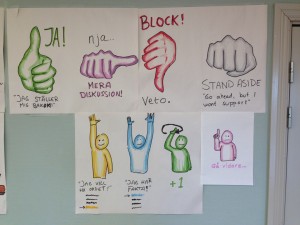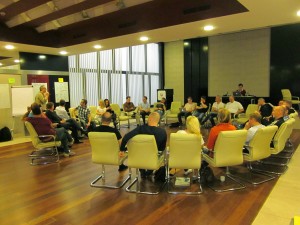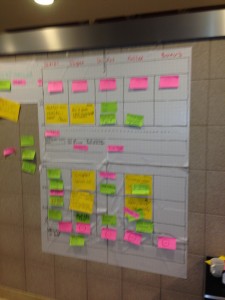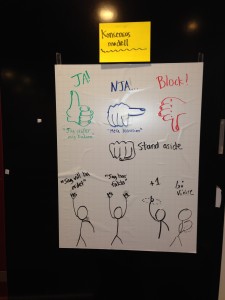
At Crisp we try to use consensus when making important decisions. Why do we do that?
Crisp is a very flat company. Most of us have no boss and report to no one. Basically you can be part of Crisp in two ways: either you have your own firm and have a partner contract with Crisp (all consultants have this) or you are employed by Crisp (administrative personnel). Crisp is owned by most (but not all) of the members/partners. The owners have, however, renounced their right to run the company (from all but legal necessities). This means that the company is run by all partners and employees with an equal vote each. We no longer have a CEO and we elect our board. This means we have to have good ways of making decisions together. And consensus is a very good way of making decision in a flat group like ours.
Why? Because consensus is so such a good method to use to create effective (not necessary efficient though) decisions in horizontal groups. It’s fairly common to confuse consensus with compromise. But it’s actually (when practiced well) the opposite. Consensus is reaching a decision which everyone can support affirmatively, not luke warm. You keep discussing until you reach a conclusion no one is blocking. This gives decisions made by consensus three important properties:
- Consensus makes the group stronger by actively fostering full participation and mutual understanding.
- Consensus drives more creative solutions by creating an inclusive environment where we try to build on each others suggestions and opinions. Decisions made by consensus are therefore often emergent.
- Consensus lead to high commitment. Implementing decisions made by consensus is often fast and painless since every one involved are already onboard.
Compare this to majority vote, for example, where the group risk being split into opposing camps, each driving its own agenda, where there will be losers, who will be part of implementing the winners ideas. How good is that for the group, for the quality of the decisions and ease of implementation? Not much, I would say. (Since Crisp is not an hierarchy I will not go into the benefits of consensus in such organizations here. You guess.)
In small groups consensus is often spontaneously used, since not using consensus would quickly create division within the group. In larger groups it is often necessary to more formally decide if and how to use consensus.
Crisp is actually very much based on the idea of “law of two feet”. In many ways it’s the opposite of consensus. It basically says: do whatever you want, you your self or together with others, as long as it does not hurt Crisp or requires common resources. Most work life stuff we decide over on our own: from where to work over how much to work to which insurances to have. This means that the number of decisions we need to take together is not that many, but they are often tough, since they are about our commons: the Crisp brand and the Crisp company.

Twice a year we gather in a company wide conference, where we sit in a big circle and discuss, or break out in voluntary mini circles á la open space. This is our agora, our main place where we make decisions (we also try to have regular so called pulse meetings where we can make decisions together, although with declining attendance, and we have an operational board who can handle economic and personnel issues between conferences, we also sometimes makes decisions by mail).
Crisp is constantly experimenting with different ways of managing ourselves. Lately we have been experimenting with making our consensus process a little bit more thought through, to follow “strong” consensus practices.
In Crisp we vote with our hands and thumbs. This is a very common consensus technique (but not the only one available). When I started in Crisp we had a voting process where we voted thumbs up if we where positive, thumbs down if we did not like the suggestion, and side way if we sort of did not care. We kept discussing until we had no thumbs down (we also have a somewhat informally defined fallback, which means that if we need a decision and it drags on forever, we might decide with qualified majority vote, but we don’t manage for that exception, and it’s fairly common that groups making decisions with consensus has such a fallback).
This worked, but I had an itching feeling about what the side way thumb actually meant. Did a side way thumb mean support of the suggestion? What kind of support then? To me it seemed as if we often where making decisions with luke warm support. It was – to me at least – hard to separate ”I don’t care”, from “I don’t know”, or “I want do discuss more”. I would like to call that “weak consensus”. Since consensus drives group cohesion, and a group like Crisp need cohesion, I wanted to test if we could tweak the way we did consensus and introduce somewhat more formality in the process.
Our autumn conference was facilitated by Jimmy Janlén and me. We decided to introduce a somewhat modified consensus model, and we also changed the conference agenda somewhat.
In our new consensus model we said that thumbs up meant “Yes, with a commitment”, thumbs down meant “Block” and side way thumb we defined as “Maybe”. We also added what in consensus circles is called “stand aside”, with the fist symbol. Stand aside is normally seen as an exception, a possibility for someone to stand aside by purely private reasons (conscience). We, however, wanted to test another idea: would it not be good if we could make the decisions circles smaller by actually only getting the one interested and affected by a decision to join a circle (“law of two feets”). One way to drive and visualize that would be to show by a fist that you where not interested in being part of the decision (but would respect the result).
We also structured the agenda so that it would be possible to get a good dynamic between open space sessions in smaller circles and decisions in the bigger circle. By doing a consensus vote, we could for example see if there where only a small group effected (lots of fists) or if it would be hard to come to a decision in the current circle (one or more Blocks). This would make it possible to create an open space session about the topic or just have additional corridor talks before trying to make the decision again.

We tried it, and it worked somewhat. We did not want the question of the consensus model to dominate the conference, so we actually introduced it somewhat vague, and then just tried to use it. There where at least no big protests against the new model.
A couple of weeks ago with had a conference again. This time Henrik Kniberg and I did the facilitation. We decided to keep the new consensus model and make the global circle time part of the open space agenda. Anyone could post a note in the common lane during the conference day, and we could then prepare any facilitation needed for the conference. It worked very well. Especially, I would dare to say, the stand aside. By having a clear way of stepping out of the circle, we now have the possibility to create really strong decisions in groups/circles that really care.
Why did we not make a consensus decision about the consensus model? I guess we where afraid of ending up in process discussions and going home drained on energi and without any real results. Eventually the question of what the signs actually meant came up, and we did as we have gotten used to, we held a break out sessions about the meanings of the different hand signs and then used the new consensus definitions to vote for the definitions (meta!). Full acklamation. Here’s our new (version 2.1) consensus model:
- Thumbs up: Yes, I actively support
- Thumbs side way: Discuss more, I don’t have all the facts yet
- Thumbs down: Block, I have all the facts needed to say no, but I am willing to talk about it
- Fist: Stand aside, I’am not interested or involved for now, but I will not stop you from following through on your decision

Our decision model now look something like this:
- Anyone who want a decision puts a note in the “global” lane (or just speaks out, law of two feets if you remember)
- The suggestion to decide upon is presented
- A first voting round is made
- If all thumbs are up, decision is made, else we continue
- If there are a lot of disagreement or a lot of stand asides, the decision is (probably) immediately postponed
- Otherwise any one or every one with a side thumb is heard. If it’s possible the suggestion is adapted to new arguments or needs heard
- Any blocker is checked if still blocking. Normally a block takes to long time to be able to treat in the big circle. The blocker(s) and the driver (and any other interests) are asked to make this an open space subject or in other way discuss the matter. (I think we will have more groan zone stuff in the future.)
- Subject is treated in smaller a circle
- Subject is taken up again for decision. Same procedure as above again.
I think this is a truly useful decision model. But I am sure it will be further tweaked. That’s the way Crisp is. Try it!
Henrik Kniberg about how we make decisions and about crisp.




Thanks for taking the time to blog about this! I really like the new consensus model, now that we’re getting used to it (although I’ll admit I was sceptical at first).
Thanks 😉 I’m glad you had the patience. And also that Jimmy, Hasse, Mats and all the others really wanted to nail it, and helped with that. It will be very interesting to see what changes we will make to it in the future.
The “Nja” I think we changed slightly, didn’t we?
To be more affirmative but we need to discuss more?
You are right that the image(s) do not capture the 2.1 version, it is only found in the text. My poster with 2.1 looks so ugly though, but maybe I should use that instead.
I think the post could be even more useful if you included an example of a decision.
Having said that, I’m planning on blogging on our Visions and the use of this model, any day now…
Agreed, but I plan to write more about consensus 😉 This is just the first piece.
And Hasse, you really have to write about the vision thing. It’s so inspiring. Have you ever heard about dotmocracy? I have a very interesting book about.
Very exciting to see the evolution of your decision-making process within Crisp. Thanks for sharing, Peter.
When I read your consensus model, it reminds me of course of the Konsent model within sociocracy (if you’re not familiar with it, you might want to have a look at the section about Konsent in this article http://agiletrail.com/2012/11/08/agile-management-innovations-a-primer ). In most Konsent implementations I’ve seen so far, there are only three possible choices when it comes to decision-making: thumbs up (I am in favour of the proposal), thumbs aside (I’m okay with it), and thumbs down (I have paramount objections against the proposal). The ‘thumbs aside’ choice in sociocracy relates to your fist, whereas your ‘thumbs aside’ choice relates to the ‘thumbs down’ choice in sociocracy.
My first impulse here is that I see an opportunity to simplify. Any indication of ‘I need more discussion here’ could be treated as an objection (‘I can’t decide yet, since I need more information. Therefore I object.’). That could simplify your whole decision process. You had this simplified version, though, in a previous version than the current one, and called it ‘weak consensus’.
I find it fascinating that you seemed to have ‘fixed’ the weak consensus with more process. When I had the feeling of a week consensus with groups where I facilitated the decision-making process, I made the choices more explicit and clear. The ‘thumb aside’ in sociocracy does not mean ‘I don’t care’ or similar, it means ‘I fully support the decision, but I won’t take action. I might not care, but I am aware that I am fully responsible for the outcomes and consequences of this decision.’ Usually that worked for groups where I introduced Konsent. I wonder why that didn’t work for Crisp.
Thanks again for sharing. Fascinating topic.
The emoji consensus model